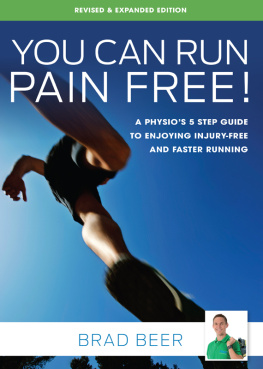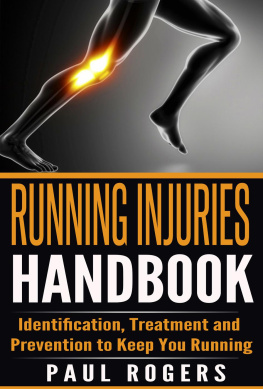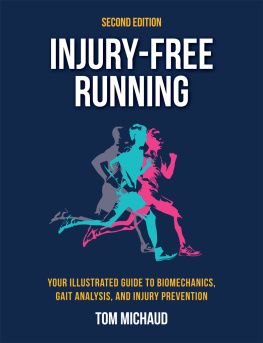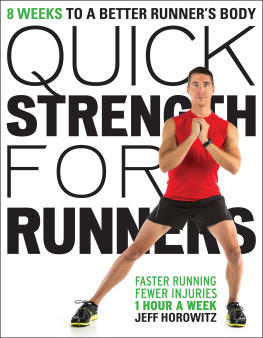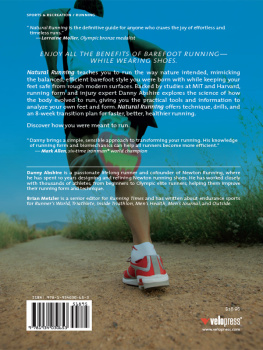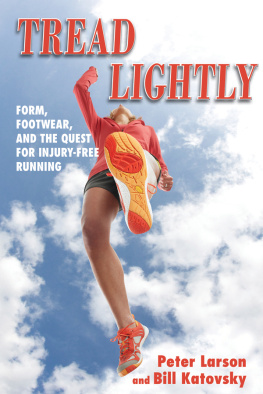RUNNING FORM
HOW TO RUN FASTER AND PREVENT INJURY
Owen Anderson, PhD
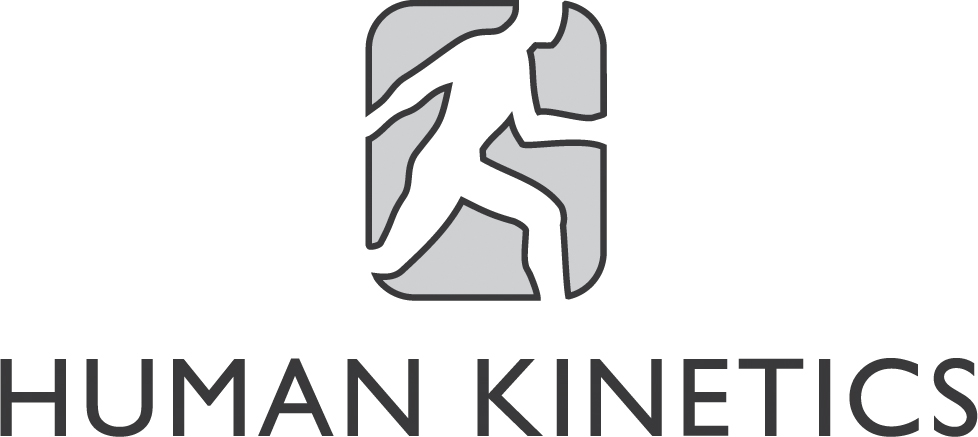
Library of Congress Cataloging-in-Publication Data
Names: Anderson, Owen, 1947 author.
Title: Running form : how to run faster and prevent injury / Owen Anderson, PhD.
Description: Champaign, Illinois : Human Kinetics, [2018] | Includes bibliographical references and index. | Description based on print version record and CIP data provided by publisher.
Identifiers: LCCN 2017024200 (print) | LCCN 2017031218 (ebook) | ISBN 9781492551409 (ebook) | ISBN 9781492510383 (print)
Subjects: LCSH: RunningTraining. | Physical fitness.
Classification: LCC GV1061 (ebook) | LCC GV1061 .A54 2018 (print) | DDC 796.42dc23
LC record available at https://lccn.loc.gov/2017024200
ISBN: 978-1-4925-1038-3 (print)
Copyright 2019 by Owen Anderson
All rights reserved. Except for use in a review, the reproduction or utilization of this work in any form or by any electronic, mechanical, or other means, now known or hereafter invented, including xerography, photocopying, and recording, and in any information storage and retrieval system, is forbidden without the written permission of the publisher.
Notice: Permission to reproduce the following material is granted to instructors and agencies who have purchased Running Form: How to Run Faster and Prevent Injury : p. 67. The reproduction of other parts of this book is expressly forbidden by the above copyright notice. Persons or agencies who have not purchased Running Form: How to Run Faster and Prevent Injury may not reproduce any material.
The web addresses cited in this text were current as of October 2017, unless otherwise noted.
Acquisitions Editors: Tom Heine, Michelle Maloney
Developmental Editor: Anne Hall
Managing Editor: Caitlin Husted
Copyeditor: Jackie Gibson
Indexer: Nancy Ball
Permissions Manager: Martha Gullo
Graphic Designers: Joe Buck, Julie L. Denzer, Angela K. Snyder
Cover Designer: Keri Evans
Photograph (cover): Getty Images/AFP/Fabrice Caffrini
Photographs (interior): Jason Allen, unless otherwise noted
Photo Asset Manager: Laura Fitch
Visual Production Assistant: Joyce Brumfield
Photo Production Manager: Jason Allen
Senior Art Manager: Kelly Hendren
Illustrations: Human Kinetics
Printer: Versa Press
We thank the Okemos High School in Okemos, Michigan for assistance in providing the location for the photo shoot for this book.
Human Kinetics books are available at special discounts for bulk purchase. Special editions or book excerpts can also be created to specification. For details, contact the Special Sales Manager at Human Kinetics.
Printed in the United States of America
10 9 8 7 6 5 4 3 2 1
The paper in this book is certified under a sustainable forestry program.
Human Kinetics
P.O. Box 5076
Champaign, IL 61825-5076
Website: www.HumanKinetics.com
In the United States, e-mail info@hkusa.com or call 800-747-4457.
In Canada, e-mail info@hkcanada.com.
In Europe, e-mail hk@hkeurope.com.
For information about Human Kinetics coverage in other areas of the world, please visit our website: www.HumanKinetics.com
E6558
Contents
Acknowledgments
owe a debt of gratitude to a large number of very special people who have assisted with the creation of this book.
Without the assistance of my great friend and colleague Walt Reynolds, this book would never have been possible. Almost every week for over two years, Walt and I discussed running form in great detail over lunches of raw fish, miso soup, noodles, and scalding-hot green tea. It was Walt who introduced me to the unique form terminology used in this volume, including the all-important SAT (shank angle at touchdown), MSA (maximal shank angle), ROS (reversal of swing), FAT (foot angle at touchdown), and the incredibly important golden ratio (ROS/MSA), which determines which runners will be found on the podium at the ends of elite competitions orin the case of non-elite runningwhich runners are most likely to be injured as they pursue their running goals. It was Walt who made the amazing discovery that, with just one exception, world-record holders at distances ranging from 100 meters to the marathon all shared a common SAT. Walt found that Usain Bolt (world-record holder for 100 meters) and Dennis Kimetto (world-record holder for the marathon) land on the ground with their legs in very similar positions, leading to the discovery that there is an optimal way of striking the ground. Walt also created an important new definition of running economy: the velocity a runner can attain in relation to the impact forces he creates with the ground . Walt is currently coaching Mark Otieno, a sprinter who holds the Kenyan records for 100 and 200 meters. I consider Walt the most knowledgeable running form expert in the world, and you will find his concepts and recommendations throughout this book.
I am also indebted to the elite Kenyan distance runners I am currently coaching and managing, who utilized both the video-form analysis described in this book and also the recommended form drills to improve their performances significantly. Cynthia Limo (silver medalist in the 2016 IAAF World Half Marathon Championship and first-ranked road racer in the world as ranked by ARRS in 2016), Mary Wacera (world silver and bronze medalist in the 2014 and 2016 IAAF World Half Marathon Championships), Monicah Ngige (two-time winner of the Cooper River Bridge Run 10K and champion of the 2017 Monterey Bay Half Marathon), Mary Wangui (victor at the 2017 Tulsa Run 15K), Iveen Chepkemoi (first in the 2017 AK Sotik Cross Country meeting in Kenya), and Gladys Kipsoi (winner of the 2017 Pittsburgh Half Marathon) all employed the techniques described in this book to improve their performances and decrease their risk of injury.
A number of sub-elite runners I am currently coaching were also instrumental in improving the book. Dr. Larry Kurz, Rabbi Lawrence Kelemen, Yaakov Nourollah, Dr. David Rosmarin, Charlie Morrow, Meir Kaniel, Paul Gray, Rabbi Elie Karfunkel, Rifky Karfunkel, Yisroel Gelber, Yosef Weissman, and Omeed Hakimi have all utilized the techniques described in this book to run faster while keeping the injury bug at bay. I owe an extra-special debt to Larry Kurz, Rabbi Kelemen, and Yaakov Nourollah for their incredible faith, friendship, and unending support.
I am also extremely grateful to my editors at Human Kinetics. Anne Hall, Caitlin Husted, Michelle Maloney, and Tom Heine worked tirelessly to bring this book to fruition and have provided perfect guidance and assistance. They were patient and supportive always, even when the time devoted to coaching and managing my elite team resulted in long writing droughts. My editors vast skills at improving the writing found in this volume and at pairing text with essential photos, figures, and illustrations have improved this book immeasurably.
I have also been helped enormously by the research carried out by other scientists. Notably, the investigations conducted by Peter Weyand at the Locomotor Performance Lab at Southern Methodist University, Daniel Lieberman of the Department of Human Evolutionary Biology at Harvard University, and Irene Davis at the Harvard Medical School and the Spaulding National Running Center have provided key insights concerning vertical and horizontal propulsive forces during gait, the effects of running form on impact and propulsive forces, and the interactions between various aspects of running form and both performance and the risk of injury.
Next page

